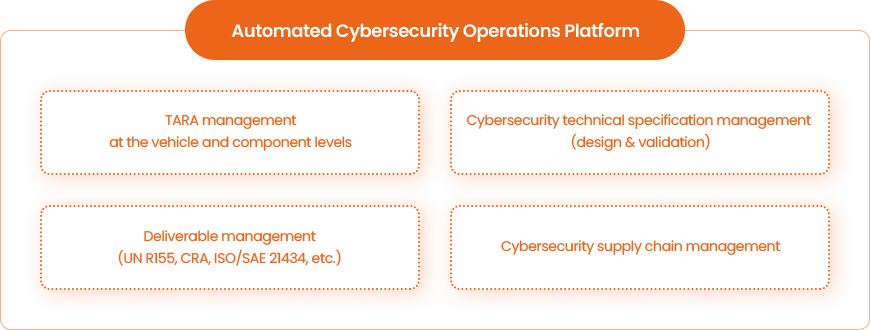Cybersecurity regulations are expanding beyond passenger vehicles (e.g., UN R155, Korean Motor Vehicle Management Act, GB 44495-2024) to include agricultural and
construction machinery under the Cyber Resilience Act (CRA).
Manufacturers are now overwhelmed by a surge in cybersecurity demands driven by complex supply chains, diverse derivative models, and varying regulatory requirements
across countries. Are you still struggling to manually juggle fragmented cybersecurity workflows across multiple domains? With a fully automated system, you can unify
your processes, ensure unwavering consistency and achieve unprecedented operational efficiency—all within a single platform.
cybersecurity regulations and hundreds of deliverables?
-
Complicated workflows make cross-functional collaboration challenging.
-
Managing hundreds of deliverables one by one is overwhelming.
-
Continually handling TARA(Threat Analysis and Risk Assessment) tasks at both the vehicle and component levels is demanding.
-
Maintaining cybersecurity post-certification continues to require significant resource.
ensuring cohesive documentation and streamlined workflows.
-

- TARA Management at the Vehicle
and Component levels -
- Providing TARA management templates
- Managing security assets, threats, and vulnerabilities
- TARA history tracking
- TARA Management at the Vehicle
-

- Technical Specification Management
by Component (Design & Validation) -
- Defining and tracing security requirements
- Security design document management
- Test case and result management
- Technical Specification Management
-

- Systematic Document Management
for Country-specific Regulatory Compliance -
- Providing templates for standards and regulations
(e.g., UN R155, CRA, ISO/SAE 21434) - Version control for all deliverables
- Always up-to-date with current regulatory requirements
- Providing templates for standards and regulations
- Systematic Document Management
while increasing efficiency and consistency in quality.
